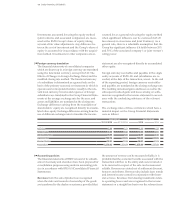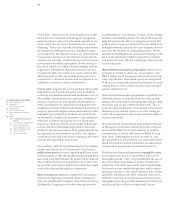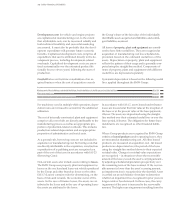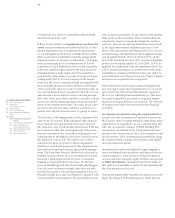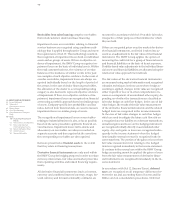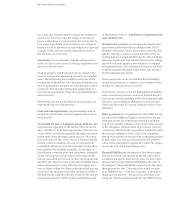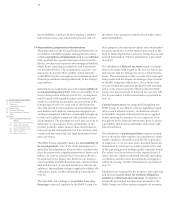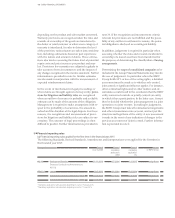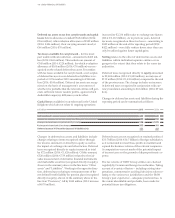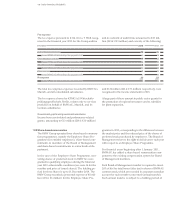BMW 2015 Annual Report Download - page 111
Download and view the complete annual report
Please find page 111 of the 2015 BMW annual report below. You can navigate through the pages in the report by either clicking on the pages listed below, or by using the keyword search tool below to find specific information within the annual report.111 GROUP FINANCIAL STATEMENTS
financial assets. IFRS 9 amends the recognition and
measurement requirements for financial assets,
in-
cluding various hybrid contracts.
Financial assets are measured at either amortised cost
or fair value. IFRS 9 harmonises the various rules
con-
tained in IAS 39 and reduces the number of valuation
categories for financial instruments on the assets side
of the balance sheet.
The new categorisation is based partly on the entity’s
business model and partly on the contractual cash flow
characteristics.
In October 2010, additional rules for financial liabilities
were added to IFRS 9. The requirements for financial
liabilities contained in IAS 39 remain unchanged with
the exception of new requirements relating to the
measurement of an entity’s own credit risk at fair value.
A package of amendments to IFRS 9 was announced
on
19 November 2013. On the one hand, the amend-
ments overhaul the requirements for hedge accounting
by introducing a new hedge accounting model. They
also enable entities to change the accounting for lia-
bilities
they have elected to measure at fair value, such
that fair value changes due to changes in “own credit
risk” would not require to be recognised in profit or loss.
The mandatory effective date of 1 January 2015 was re-
moved and a new application date of 1 January 2018 set.
The impact of adoption of the Standard on the Group
Financial Statements is currently being investigated.
Based on analyses to date, the new rules are not expected
to have a material impact in terms of the classification
and measurement of financial instruments when the
Standard is adopted. As far as the accounting for hedging
relationships is concerned, analyses to date indicate
that it will be possible to account for the majority of
commodity hedging contracts using hedge accounting
rules. As a result, fluctuations in the price of hedging
contracts during their term will be presented as a com-
ponent of accumulated other equity, thus reducing vola-
tility in reported earnings.
In May 2014 the IASB issued IFRS 15 (Revenue from
Contracts with Customers) together with the Financial
Accounting Standards Board. The objective of the new
Standard is to assimilate all the various existing require-
ments and Interpretations relating to revenue recogni-
tion (IAS 11 Construction Contracts, IAS 18 Revenue,
IFRIC 13 Customer Loyalty Programmes, IFRIC 15 Agree-
ments
for the Construction of Real Estate, IFRIC 18
Transfers of Assets from Customers, SIC-31 Revenue –
Barter Transactions involving Advertising Services) in
a
single Standard. The new Standard also stipulates uni-
form revenue recognition principles for all sectors and
all categories.
The new Standard is based on a five-step model, which
sets out the rules for revenue from contracts with
cus-
tomers, with the exception – among other things – of
lease arrangements, insurance contracts, financial
in-
struments and specified contractual rights and obliga-
tions relating to non-monetary transactions between
entities within the same sector. Revenue can be recog-
nised either over time or at a specific point in time.
The five-step model describes the five steps necessary
to recognise revenue on the basis of the transfer of
control:
1. Identify the contract with the customer
2. Identify the performance obligations in the contract
3. Determine the transaction price
4. A
llocate the transaction price to separate performance
obligations
5. Recognise revenue when a performance obligation is
satisfied.
A major difference to the previous Standard is the
in-
creased scope of discretion for estimates and the
intro-
duction of thresholds that could influence the amount
and timing of revenue recognition.
The impact of adoption of the new requirements on the
Group Financial Statements is currently being assessed.
In the case of multi-component contracts with variable
consideration components, it is possible that a change
in the allocation of transaction prices may result in an
earlier recognition of revenues. Buy-back arrangements
with customers could result in the need to change the
accounting treatment, with revenues being recognised
either earlier or later by the BMW Group, depending
on the individual case. Accounting for rights of return
could, under certain circumstances, result in the need
to record eliminations between the operating segments
at an earlier stage. Any such changes would only have
an impact at the moment of first-time adoption, not,
however, during the period in which the new rules are
adopted or in subsequent periods.
IFRS 15 – subject to EU endorsement – is mandatory for
the first time for annual periods beginning on or after
1 January 2018. Early adoption is permitted. In July 2015,
the IASB also published an Exposure Draft containing
clarifications to the Standard, as a consequence of which
the Standard may be amended. For this reason, the
potential impact of applying IFRS 15 cannot be reliably
assessed at present.


